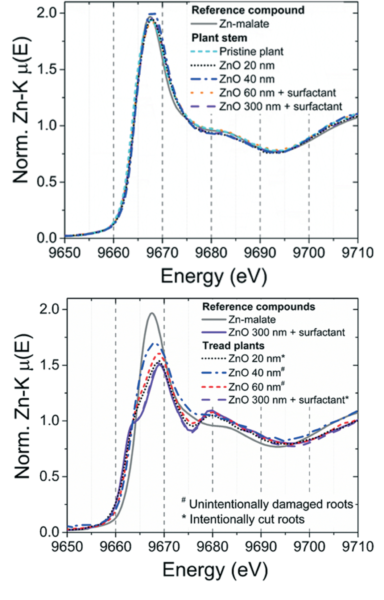Research investigates mechanism of absorption and transport of zinc nanoparticles
In agriculture, several of the nutrients needed for the growth and development of plants are supplied or supplemented by fertilizers. Some nutrients, such as phosphorus ($ \rm P $) and potassium ($ \rm K $), are needed in large quantities, but obtained from limited mineral sources. Others – such as manganese ($ \rm Mn $), copper ($ \rm Cu $) or zinc ($ \rm Zn $) – are only needed in small quantities and their excessive application can be toxic to plants or to important microorganisms present in the soil.

Figure 1: Zn-K edge XAS spectra recorded at the stem of common bean (Phaseolus vulgaris) plants whose roots were (upper plot) not damaged and (lower plot) damaged. In the first situation, Zn was found mainly associated with malate. In the second situation, when roots were intentionally damaged, ZnO nanoparticles were detected in the stem.
Therefore, there is an intense search for new fertilizers that allow the rational delivery of the nutrients necessary for agriculture, avoiding their use in a manner that is excessive, inefficient or potentially harmful to the environment. Nanomaterials, since they can have their properties adjusted for the most varied applications, are also candidates for this smart fertilization.
Thus, Tatiana N.M. da Cruz et al. [1] used the facilities of the Brazilian Synchrotron Light Laboratory (LNLS) to investigate the mechanisms of absorption and transport of nanoparticles by plants and the use of zinc oxide ($\rm ZnO$) nanoparticles for the supplementation of zinc, an essential chemical element for various enzymatic processes.
The researchers subjected common bean plants (Phaseolus vulgaris) to nanoparticle dispersions to analyze the effect of both the size and concentration of the nanoparticles as well as the presence of surfactants in the absorption of Zn.
Among the analyses, in vivo X-ray absorption experiments performed in the LNLS’ XAFS2 beamline showed that zinc is not transported within the plant in the form of ZnO nanoparticles, but associated with organic molecules such as malate, citrate and histidine, as shown in Figure 1.
The results indicate that the nanoparticles are first dissolved in the soil prior to their absorption, and that whole nanoparticles are absorbed only when the roots of the plants are damaged. It was also observed that the nanoparticles of smaller size and associated with surfactants presented the highest absorption rates.
Thus, according to the group, by controlling the size of the nanoparticles and the addition of surfactant it would be possible to control the delivery of nutrients, reinforcing the perspective of the use of nanomaterials in agriculture.
Source: [1] Tatiana N. M. da Cruz, Susilaine M. Savassa, Marcos H. F. Gomes, Eduardo S. Rodrigues, Nádia M. Duran, Eduardo de Almeida, Adriana P. Martinellia and Hudson W. P. de Carvalho, Shedding light on the mechanisms of absorption and transport of ZnO nanoparticles by plants via in vivo X-ray spectroscopy, Environ. Sci.: Nano, 2017, 4, 2367-2376. DOI:10.1039/C7EN00785J.
Research analyzes the deactivation of nickel catalysts in dry reforming of methane
Research investigates the addition of ceria on the activity of catalysts for the water-gas shift reaction